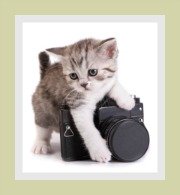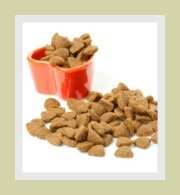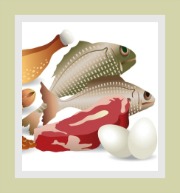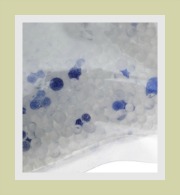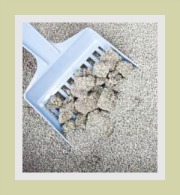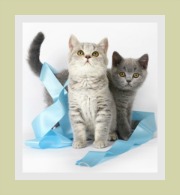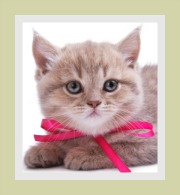Types of Cat Food
Tips on Feeding Your Cat
Love and the best cat food you can afford is what our feline companions deserve.
Cats are carnivores which means they need a feline diet rich in animal-based nutrients.
To gain a better understanding of cat nutrition we provide details on cat diet and their nutritional requirements. This information will guide you on what to look for on commercial feline food labels.
In this chapter we provide you with information on the various types of food and tips on feeding your cat.
types of feline foods
Commercial cat foods are available in different forms. For ultimate cat nutrition, give careful consideration to the one you elect to feed your cat:
|
known as kibble or biscuits |
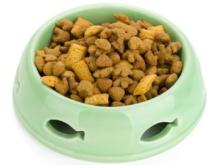 |
|
known as wet or moist food |
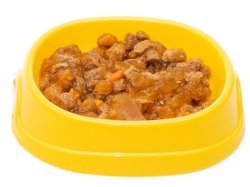 |
|
natural cat food |
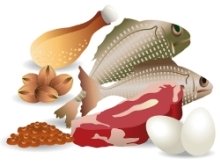 |
categories of feline food types
Consult your vet or a feline nutritionalist about special health-related diets.
life stage feline diet
The nutritional demands of kittens are very different to that of the geriatric cat.
For example, the geriatric cat will have a less efficient digestive system, their sense of taste and smell may have decreased, their immune system may be weaker and they may suffer from arthritic and urinary tract problems.
lifestyle feline diet
Indoor cat vs Outdoor cats - cats living outdoors will probably need a diet higher in proteins and calories
cat breed type
Today commercial cat food manufacturers produce breed specific diets.
For example, the longhaired cat breeds like the Persian will need a diet that will control hairball and a uniquely shaped pellet to assist these flat-faced cats to eat their kibbles.
health specific or special feline diet
If your cat requires a special diet as a result of a health condition there are specifically formulated cat foods for certain conditions:
-
suffering from food allergies (hypoallergenic diets)
- diets for
hairball
- sensitive digestive systems
- cardiac (heart)
- renal (kidney)
- diabetic feline food and
- low calorie diets for obese cats
tips on feeding your cat
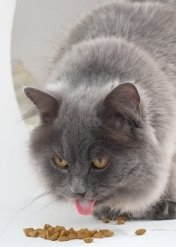
Cat feeding begins with appropriate cat bowls and water bowls.
To be sure that you select the right cat food bowls, visit our comprehensive page that provides details about the pros and cons of cat bowls.
If you have a multiple cat household, provide each cat with its own feeding bowl.
Select the food most appropriate to your cat.
Find an appropriate area to place your cat's food
and water bowls. Once you have decided on the area, be sure not to
change the location.
Never place the food bowls in the vicinity of the cat litter box.
Never place the food bowls in a high traffic area.
Choose an appropriate time to feed your cat and
establish a routine.
The age of the cat will determine the frequency and
daily ration:
- Kittens: 05 - 12 weeks - 5 small meals a day
- Kittens: 12 - 20 weeks - 4 small meals a day
- Kittens: 20 - 30 weeks - 3 meals a day
- Kittens: 30 - 12 months - 2 meals a day
- Adult cats need 1 - 2 meals a day
Pregnant and lactating mothers need to be fed 3 times a day.
Follow the guidelines on the packaging for the quantity and frequency.
Dry kibbles can be left out for those who free-feed their cats.
Moist food spoils in a couple of hours and must be replaced.
Cat treats can be fed to your cat but do follow these important cat treats guidelines.
Water is an essential part of cat nutrition. Your cat must have access to clean and fresh water daily.
If possible, train your cat early on to eat a wide selection of different cat foods. This will be assist greatly if their favorite food is taken off the market.
Unless there is a medical indication, it is undesirable to change your cat's food.
If your cat is content and thriving on their diet, we would suggest that you not change their food.
If circumstances dictate a change, do the change gradually. Mixing the old and new food together may make the transition less traumatic.
Do remember that cats feed differently to dogs. Our feline companions are 'nibblers'.
They elect to eat several small meals a day (10 - 15) and each of their meal sittings lasts only a few minutes (3 - 4 minutes).
Cats are fussy eaters, they prefer their food at room temperature.
If their food is stored in the refrigerator, be sure to warm it up.
Cats generally do not chew their food. They may bite the food once before sending it down the digestive tract.
Should you have any questions regarding your cat's health or nutritional
needs, always consult with your veterinarian.
Top of Cat Food Page
search our site
please like us
share our site
recommend on google
popular pages
